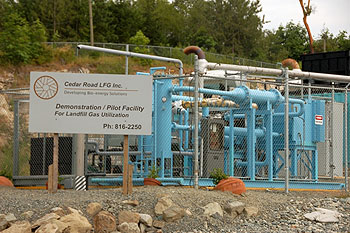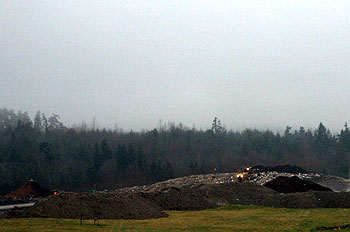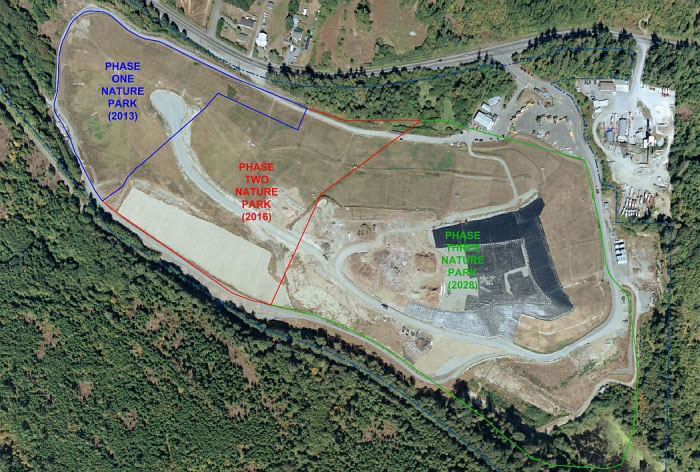Design and Operations Plan - RDN Regional Landfill
Background & Objectives
 |
| The D & O Plan will enhance the Regional Landfill's landfill gas collection system, which provides feedstock for the on-site landfill-gas-to-energy facility. |
The D & O Plan ensures that the Regional Landfill's design and operations minimize potential impacts on human health, the environment, and adjacent properties and their residents. These include surface and ground water protection and monitoring and landfill gas management.
The Regional Board approved the draft D & O Plan in 2009 following a positive response to consultations with households adjacent to the landfill and it received BC Ministry of Environment approval in August 2010.
Objectives
- Adopt the requirements of the landfill's Operational Certificate issued by the BC Ministry of Environment;
- Address Cell One (closed unlined landfill area) leachate issues resulting from settling of waste;
- Plan and integrate progressive closure of the landfill site to support phasing in the development of the nature park concept;
- Identify key infrastructure and environmental control elements and coordinate them with ongoing development and operation of the site, staged expansion, and progressive closure;
- Enhance the landfill gas (LFG) collection system to reduce greenhouse gas emissions and provide feedstock for the on-site landfill-gas-to-energy facility;
- Update the landfill fill plan and integrate it with environmental controls (surface water, leachate and LFG management);
- Review and update the landfill's environmental monitoring programs to reduce impacts from landfill operations;
- Optimize available landfill capacity to maximize site life; and
- Forecast capital requirements for landfilling stages and infrastructure projects over a 20-year lifespan.
Cell One Remediation
 |
| Fill was added to Cell One to re-grade its slopes. |
Development of the nature park will be implemented in three phases. The first two phases will be sited on the Cell One unlined portion of the landfill, which was closed in 1996. In 2006, hydrogeological studies were conducted in support of development of the nature park.
The ground and surface water studies identified excess leachate being generated due to settling of waste in Cell One and possible bedrock conduits for leachate migration. Correcting these issues required infilling, re-grading and re-contouring Cell One to improve surface water runoff and reduce leachate generation.
Cell One area leachate and stormwater collection improvements were completed in 2009. Fill was added to Cell One in 2010 to re-grade the slopes of the area that will comprise the first phase of the nature park. During the summer of 2011 this area will be reclosed with a cover system incorporating a polyethylene liner.
Enhancing Landfill Environmental Protection, Capacity and Operations
- Developing the north berm area to address stability concerns in 1991/1995 lined portions of the landfill and facilitate a north stormwater infrastructure to improve the water quality of Fielding Creek;
- Relocation of the maintenance shop and siting a new operations/administration building; and
- Extending the southwest berm.
The D & O Plan has prepared a multi-stage fill plan that provides estimates of the total capital costs for development and final closure of the Regional Landfill, including construction of the nature park concept.
The costs of landfilling stages and infrastructure projects over a 20-year lifespan are estimated to be $36 million. Funding for these projects will be sustained through tipping fees (landfill disposal charges) with no impact on property taxes.
The nature park developed on the closed Cell One area of the Regional Landfill will be the first of its kind on a working landfill in BC.
Project construction on the Phase 1 Nature Park, comprising a 3-hectare site, is scheduled to begin in spring 2012 with public access planned for spring 2013. The Phase 2 nature park will be sited on the remaining 6-hectare section of Cell One and is expected to be completed in 2016.
A detailed design of the Phase 1 nature park, prepared by Nanaimo-based Archadia Landscape Architecture Ltd., will be completed in fall 2011. Elements of the nature park will include:
- A trail system that takes advantage of views from higher elevations;
- Landscaping with meadows comprised of native plant communities that provide habitat for beneficial insect pollinators such as bees and butterflies;
- Plantings along Cedar Road to screen landfill operations; and
- Parking and public access points.

Air photo of Regional Landfill showing phased development of Nature Park concept
